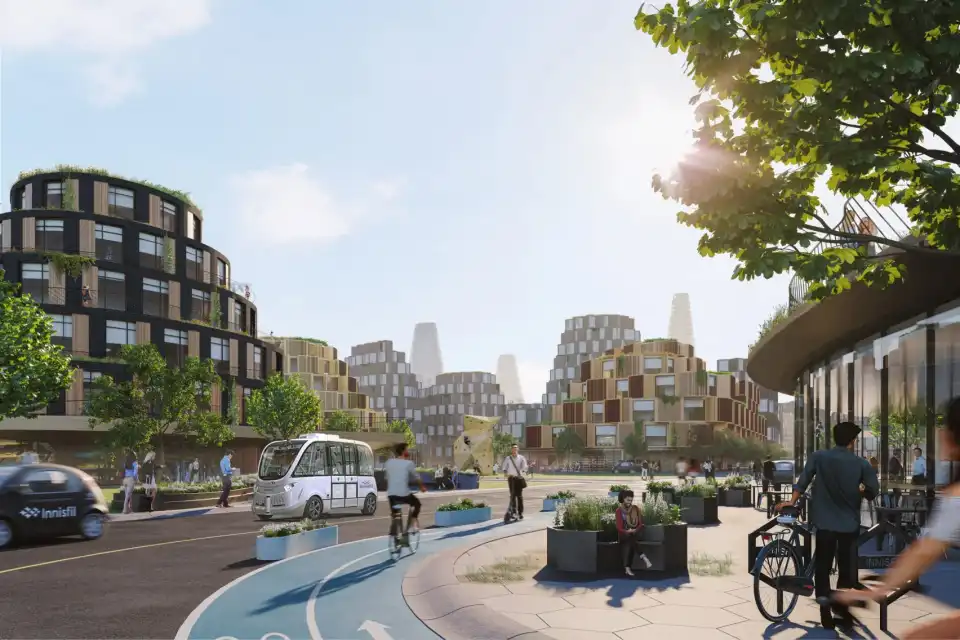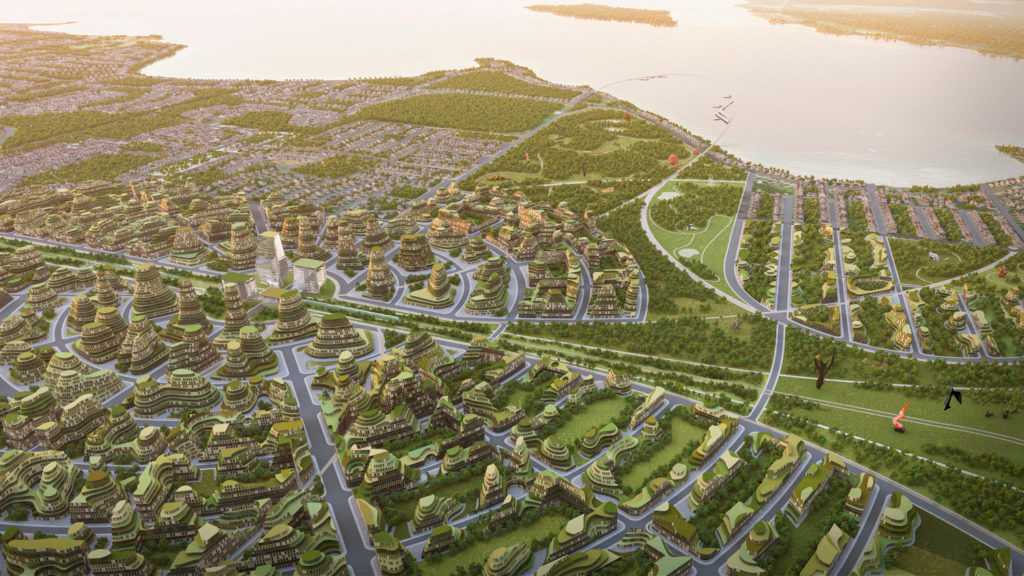Overview
The Orbit of Innisfil, Canada is an initiative aimed at reshaping urban life through sustainability and community centered design. Launched by The Cortel Group, a private real estate company, in 2019, the development envisions a high-density living area spread across 40 million square feet, projecting to house between 30,000 to 150,000 people. Innisfil is a commuter town in the Greater Toronto Area aiming to bolster its economic and social assets, with its vast greenery and proximity to Ontario being attractive to future residents. The development leverages the existing regional transit system (GO Transit), making The Orbit GO station the heart of the growing development plan. The Orbit hopes to implement IoT devices for managing utilities and infrastructure, as well as road infrastructure with the potential of handling autonomous vehicles.

Key Characteristics
Infrastructure. The Orbit strives to create a lifestyle where residents can live, work, and play in proximity. This is reflected in the high-density, mixed-use development plans that are focused around the central transit hub. By doing so, the infrastructure of this development promotes a pedestrian-friendly environment. Other infrastructure initiatives include roads suitable for zero-emission, autonomous vehicle use, energy-ready infrastructure, and integrated public safety systems.
Strategic Zoning. The Minister's Zoning Orders, or MZO for short, provides a way for planners to expedite development. Initially supported as a broader strategy to boost economic recovery and infrastructure post-pandemic within Ontario, The Orbit has used MZO to expedite the new GO station in Innisfil that will serve as the heart of The Orbit, and will further be used to expedite "major transit station, linear park, multi-use trail, and mixed-use buildings, among other elements."
Resident Engagement and Participation. The Orbit plan aims to not overshadow the local culture's lifestyle. With a sustainability approach, defined as measures and actions that, when taken, ensure sufficient resources are available for both present and future generations, the plan aims to maintain social and cultural viability. They are taking resident concerns into account through in-person information centers, online forum, and a newsletter for updates.
Goals and Aspirations
Digital Transformation and Innovation. The Orbit's development plan aims to reimagine urban living by incorporating digital innovation in the preexisting infrastructure for the enhancement of Innisfil's energy management, public safety, and transportation systems. The goal is to utilize technology to work with the people and environment, as opposed to modifying the residents' lifestyles for the sake of technological innovation.
Sustainable Infrastructure. By preserving sustainability with the intention of benefitting current and future generations of residents, The Orbit plan hopes to preserve green spaces and support infrastructure that supports energy efficiency and environmental sustainability.
Pedestrian Friendly and Public Transit Oriented. The design of the Orbit is set to incorporate modern urban planning principles, featuring a transit-oriented development that fosters walkability and reduces car dependency. The plan includes mixed-use developments that are accessible by public transportation, promoting a lifestyle where residents can live, work, and play in proximity. This goal of focusing on high-density living is also set to prevent urban sprawl.
Stakeholders
Williams Treaty First Nations Settlement. The Williams Treaty First Nations is a $1.1b settlement, approximating at $85 per acre of land, that the Town of Innisfil recognizes in their land acknowledgement. The land acknowledgement recognizes the First Nations whose traditional territories the residents of The Orbit will live on. Williams Treaty First Nations Settlement
Lake Simcoe Conservation. The Orbit's proximity to Lake Simcoe harbors a delicate balance between development and nature quality conservation. The cooperation of both parties allows for a minimal disruption to Lake Simcoe's conservation, restoration, and management. Lake Simcoe Conservation

Third Party Partners. Various third party partners, such as the Ministry of Transportation and Metrolinx are involved in order to keep The Orbit transit accessible via the pending GO station. Other stakeholders include The Cortel Group, among other developers.

Technology Interventions
Energy Management Systems. Achieving energy sustainability and resilience is possible through local power generation, reducing dependency on external sources and enhancing reliability. This is complemented by district energy systems, which distribute heating and energy efficiently across multiple buildings. Additionally, energy-ready infrastructure ensures communities can seamlessly integrate future technologies and meet evolving energy needs.
Integrated Public Safety Systems. Comprehensive security measures include CCTV systems equipped with facial recognition technology to enhance safety and monitoring. This is further supported by emergency response protocols designed to streamline the management of emergency situations efficiently. Together, these initiatives ensure a secure and responsive environment for all residents.
Smart Transportation Systems. The modal split strategy encourages walking and biking while promoting strategic use of private vehicles to reduce congestion and environmental impact. This approach is supported by transit-priority roads, which modify infrastructure to accommodate transit vehicles efficiently. Additionally, flexible infrastructure includes provisions for zero-emission vehicles and potential automation, ensuring adaptability to future transportation technologies.
Financing
Town-Funded and Developers. The Orbit is primarily financed through taxpayer dollars of the Town of Innisfil to support the development of the town. The GO station is financed by the cost of the transit developer.
Outcomes
Upcoming GO Station. The Orbit is in the designing phases of the central GO station that will serve as the heart and starting point of its development. The area surrounding this station will be the densest part of the city.
TOC2 and TOC3. Beginning in 2051, the Minister's Zoning Orders (MZO) allows for The Orbit to expand horizontally.
Open Questions
Sustainability. How will the development of The Orbit continue to remain respectful of the nature and reserves that surround it?
City Structure. How will The Orbit prevent making the infrastructure too dense, or prevent urban sprawl?
Data Privacy and Security. How will the developers of the digital technologies ensure that the residents' information is being used for what they say it is? How will they establish trust with those who are skeptical with the potential harms of technology?
Primary Sources
- Orbit
- Cortel Group
- (2022), Orbit Potential and Innovation Plan Secondary Plan_Design Development Update
Secondary Sources
- Conklin, E. (2020, January 8). Canada gives utopia a chance with the orbit. The Architect’s Newspaper. https://www.archpaper.com/2020/01/canada-utopia-the-orbit-smart-city/
- Ridder, E. (2023, March 17). 5 things residents said about Innisfil’s orbit development at public meeting. Simcoe.com. https://www.simcoe.com/news/council/5-things-residents-said-about-innisfils-orbit-development-at-public-meeting/article_8e4b382a-74f3-5a84-903c-1a2b67557278.html
- Town of Innisfil, "Ask a Planner: The Orbit Virtual Open House." Youtube, uploaded by Town of Innisfil, 19 October 2020, https://www.youtube.com/watch?v=YcNTzjAKTa0
- Town of Innisfil, "Orbit Potential and Innovation Plan." YouTube, uploaded by Town of Innisfil, 27 October 2022, https://www.youtube.com/watch?v=cH4J8v-t5Go
